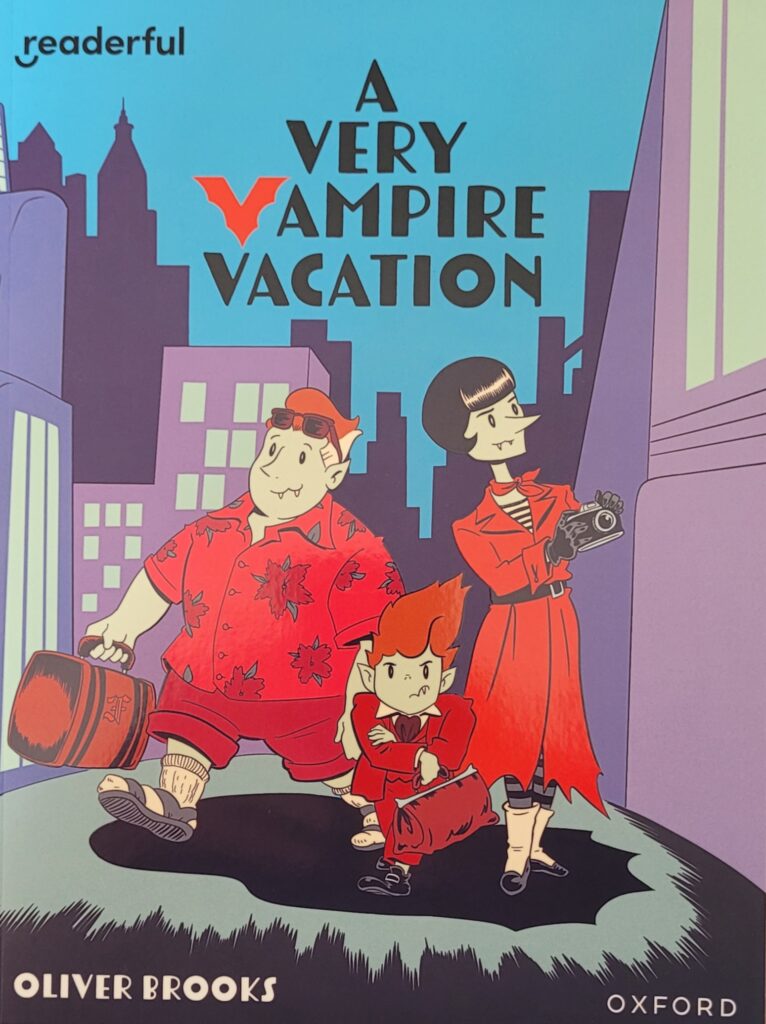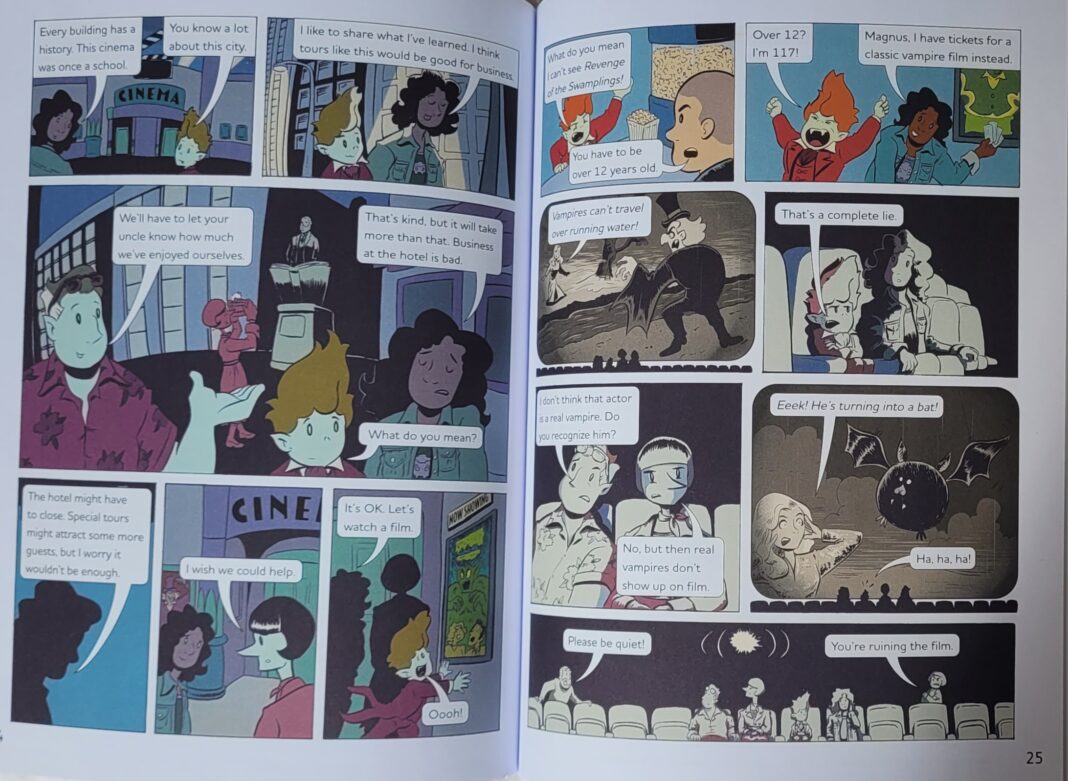Local author and illustrator, Oliver Brooks, has recently had a graphic book for children, A Very Vampire Vacation, published by Oxford University Press as part of their Readerful reading library with books designed to encourage children to read more.
In it, a family of vampires, the Flittermauses, escape from the building works in their crumbling castle by taking a holiday in the city and in so doing, have to cope with modern life, become embroiled in a thieves’ plot and learn more about themselves, each other and the world.

The book is fun and full of playful verbal and visual wit, with plenty of opportunities for misunderstandings and confusions between characters as two worlds collide – the builders repairing the castle do not realise that the vampires want darkness, the family go to the cinema to watch a vampire film and complain that it is not accurate about their lives.
Oliver thinks that the graphic novel genre can play an important role in motivating readers. “I hope that people enjoy the book and are not put off by the fact that it is a graphic novel. Comics have started to gain more respect in the last 20-30 years, but I still see a lot of prejudice towards them not being ‘proper’ books. For many years film had the same treatment, being seen as a lesser art form. But it’s all art, it’s still storytelling. One medium is not more superior to the other. You can have a lousy opera and a beautifully crafted comic. The Readerful range from Oxford University Press is dedicated to supplying schools with fun, educational graphic novels, to encourage reluctant readers to pick up a book. That is a cause I stand behind. With so many libraries under threat up and down the country, we need to make access to books as easy as possible. I am proud to be a part of that.”
You have self-published several of your children’s books. Is this your first book with a publisher? How did this come about?
This is my first book to be produced through traditional publishing. At the start of 2023, I acquired an agent, Gill McLay of the Bath Literary Agency and it didn’t take long for her to approach me with an offer from Oxford University Press, who were opening up submissions for their Readerful arm of graphic novels for schools.
What was the brief? Did you come up with the fun idea of the vampire family?
We sent the publisher four ideas for stories I had been ruminating on for a while. One was about a vampire family relocating to the city and setting up a new life in this modern world. The publisher also liked this idea, but we realised that was too big a story for the page count, so I reworked the idea to the vampires simply going on holiday.
What are the themes of the story?
The story revolves around the child vampire, Magnus, learning to accept life outside his home. Just because something is different, does not make it wrong. The way he learns this lesson is by visiting this new environment and communicating with the people there, listening to them and learning that there is more to The City than he first suspected. The City offers new sights and sounds that he would otherwise never experience. The message of the book is that travel broadens the mind.
There are so many images – how long did the writing and drawing take?
The development of the book, from start to finish, took just under a year, though I am not working on the book full-time. You send a draft off and wait a few days, weeks, or a month for feedback. Since this was a book intended for education, the publisher gave me a list of words that had to be incorporated into he script, that that particular Key Stage would be learning, which was a fun challenge to include and feel natural. Fortunately, being vampires, they would have a slightly arcane speech. I completed all the artwork, the pencilling, inking, and colour throughout February 2024, which doesn’t sound very long, but by that point I had a very tight draft and thumbnails to work from, which made the process quicker.
What is your technique?
First, I rough out the image using a non-photographic blue pencil (which doesn’t show up when scanned), sometimes, depending on the complexity of the scene, I may tighten those pencils with a 2B graphite lead. Next, I ink with a size 1 sable-haired brush, using water-resistant black ink (if we’re referring to Winsor and Newton, it’s the cartoon spider one). The water-resistant ink doesn’t smudge and dries super quick. This is all done on Bristol Board, which is a smooth surface to work on. I scan the page in and colour digitally on Affinity Designer, but any Photoshop equivalent will do. I am slightly old school when it comes to drawing. I like the feel of a pencil or brush in my hand, or the clinking of the bottle of ink. I’m using the exact same tools as my forebearers did in comics since the 1900s and that is very exciting to me.
What are your influences?
I honestly believe that creatives are influenced by everything they encounter. Even if we watch a film, or see a painting that we don’t like, we study that to learn why it didn’t work for us. My main influences, comics-wise, are the French-Belgium comics (Bande-Dessinee) like Tintin, Asterix, and the work of Matthieu Bonhomme, for their bold colour choice and graphic design. I love the comedic timing of Jeff Smith’s Bone and Bill Watterson’s Calvin and Hobbes. Another major influence on my comics is film history. I have been fascinated by the subject for the majority of my life, especially the silent era. There’s a scene in the book where the characters go to the cinema to watch an old vampire movie, and that was probably the most fun I had during the creative process.
Are there any more projects in the offing?
I have a few projects that my agent and I are sending out to publishers. I am currently working on another educational graphic novel for a different publisher, this will be a biographical comic, which is an interesting project to be working on, as it requires a different approach to the subject. As for additional stories featuring the Flittermauses, I will never say never, but only if the right idea comes along. At the present, I am satisfied with how the book ended their story.
Image Credits: Oliver Brooks/Oxford University Press .



